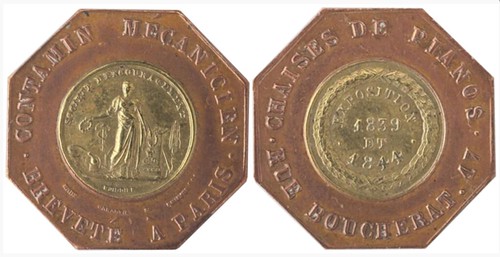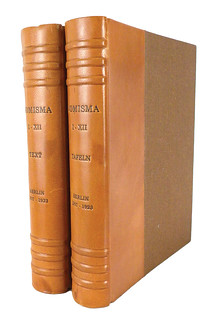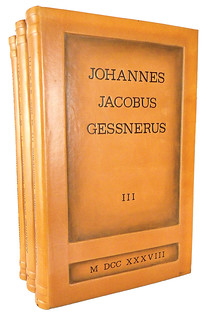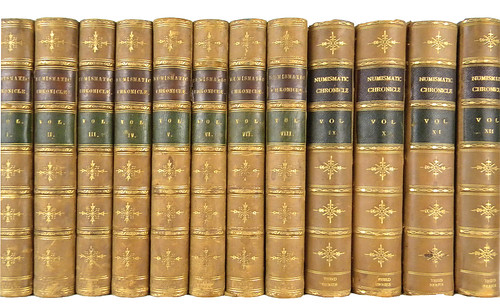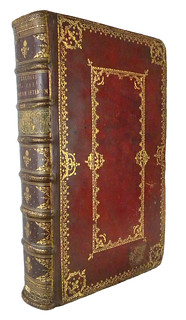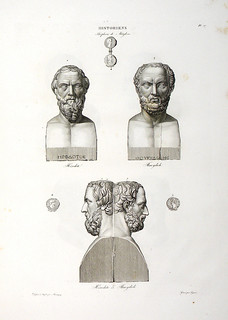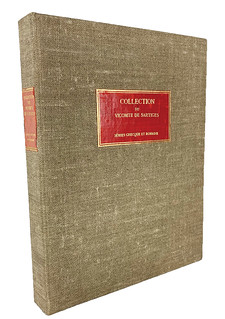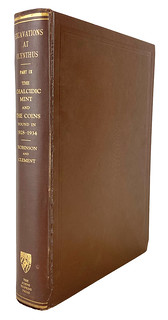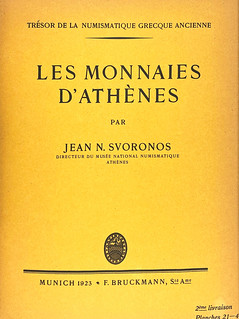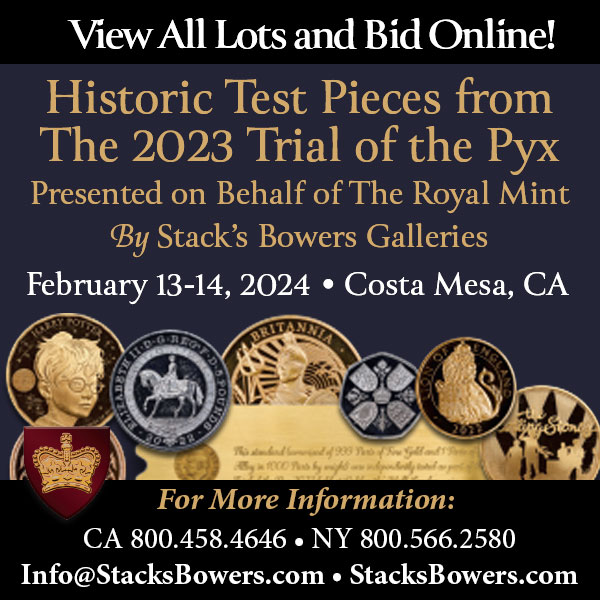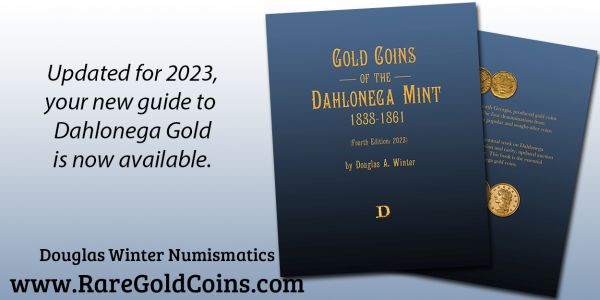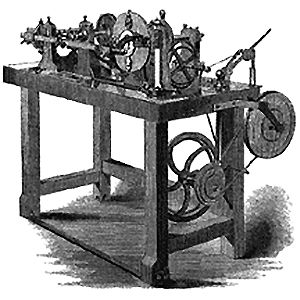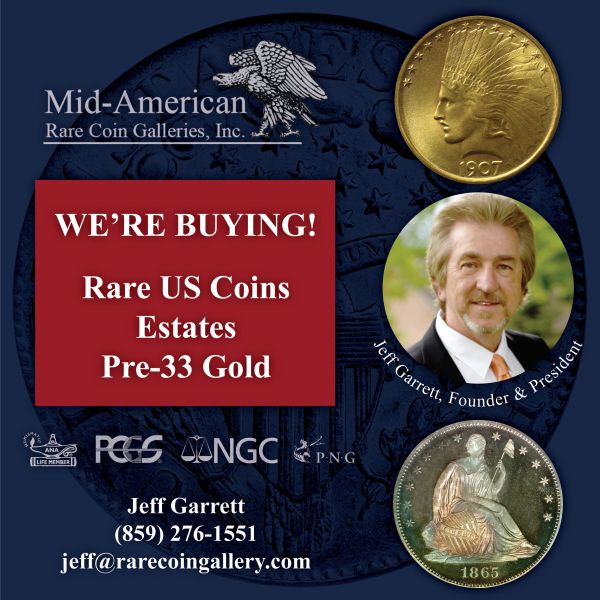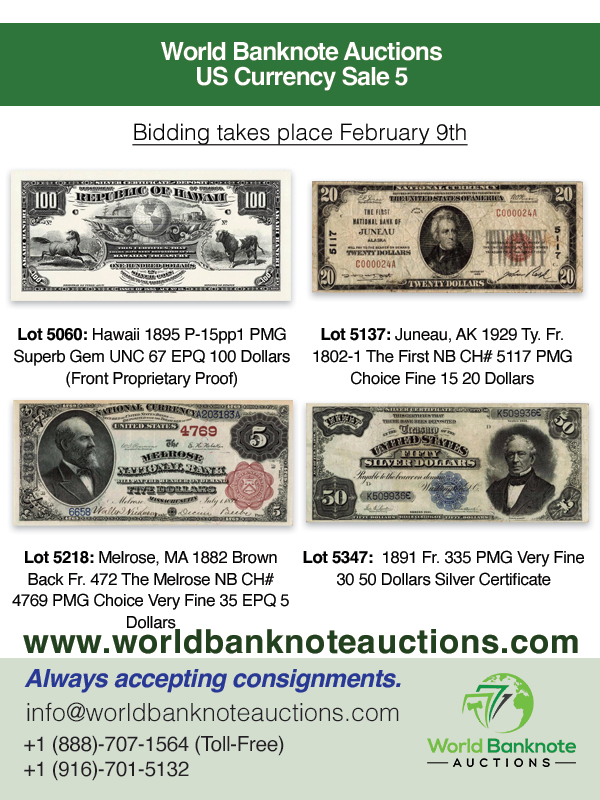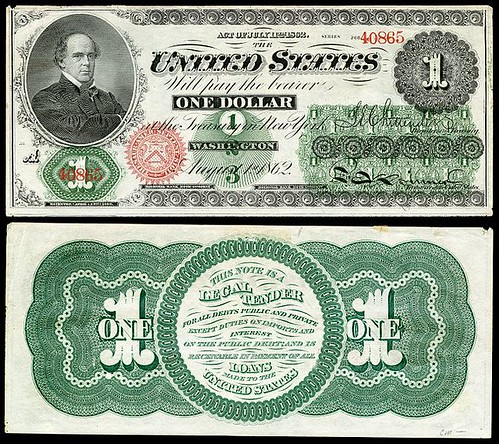
Visit our NBS Sponsors
About UsThe Numismatic Bibliomania Society is a non-profit association devoted to the study and enjoyment of numismatic literature. For more information please see our web site at coinbooks.org SubscriptionsThose wishing to become new E-Sylum subscribers (or wishing to Unsubscribe) can go to the following web page link MembershipThere is a membership application available on the web site Membership Application To join, print the application and return it with your check to the address printed on the application. Print/Digital membership is $40 to addresses in the U.S., and $60 elsewhere. A digital-only membership is available for $25. For those without web access, write to: Jeff Dickerson, Treasurer AsylumFor Asylum mailing address changes and other membership questions, contact Jeff at this email address: treasurer@coinbooks.org SubmissionsTo submit items for publication in The E-Sylum, write to the Editor at this address: whomren@gmail.com BUY THE BOOK BEFORE THE COINSale Calendar |
- WAYNE'S WORDS: THE E-SYLUM JANUARY 28, 2024
- KOLBE & FANNING BCD LIBRARY HIGHLIGHTS
- NEW BOOK: ANCIENT COINS IN LVIV MUSEUM
- NEW BOOK: LOOK AT THE COINS!
- BANKNOTE BOOK IRELAND CHAPTER PUBLISHED
- NEW BOOK: 2024 MRI BANKER'S GUIDE TO FOREIGN CURRENCY
- NEW BOOK: SAVINGS CERTIFICATES USED IN INDIA
- 2024 BRITANNIA NUMMARIA CONFERENCE
- IRA S. STEIN (1940 - 2023)
- 2024 NEWMAN GRANT PROGRAM ANNOUNCED
- VIDEO: BUST HALF COLLECTING
- PNG 2024 ANA SUMMER SEMINAR SCHOLARSHIPS
- PORTRAIT LATHE MAKER CLAUDE CONTAMIN
- NOTES FROM E-SYLUM READERS: JANUARY 28, 2024
- FANTASY BANK BAGS FOR SALE
- VOCABULARY TERM: PAPERWEIGHT
- WILLIAM SUMNER APPLETON (1840-1903)
- CANADA'S SNOWFLAKE PHOTOGRAPHER
- NEW LEADERSHIP AT ACEF
- REPLACE PUNXSUTAWNEY PHIL WITH A COIN?
- CLEMENTE COMMEMORATIVE COIN CONSIDERED
- NUMISMATIC NUGGETS: JANUARY 28, 2024
- COINS OF THE GALLIC EMPERORS
- WASHINGTON BEFORE BOSTON MEDAL
- GOLD NOBEL PRIZE MEDAL EBAY FIND
- THE DECISION TO ISSUE GREENBACKS
- ANTI-TRUMAN SCRIP OF 1952
- COMPUTER VISION REASSEMBLES SHREDDED BANK NOTES
Content presented in The E-Sylum is not necessarily researched or independently fact-checked, and views expressed do not necessarily represent those of the Numismatic Bibliomania Society.
WAYNE'S WORDS: THE E-SYLUM JANUARY 28, 2024
 Thank you for reading The E-Sylum. If you enjoy it, please send me the email addresses of friends you think may enjoy it as well and I'll send them a subscription. Contact me at whomren@gmail.com anytime regarding your subscription, or questions, comments or suggestions about our content.
Thank you for reading The E-Sylum. If you enjoy it, please send me the email addresses of friends you think may enjoy it as well and I'll send them a subscription. Contact me at whomren@gmail.com anytime regarding your subscription, or questions, comments or suggestions about our content.
This week we open with BCD sale numismatic literature highlights, five new books, a conference, one obituary, updates from the Newman Numismatic Portal, and more.
Other topics this week include the Lviv Museum collection, Ireland banknotes, collecting Bust Half Dollars, the maker of the U.S. Mint's first pantograph, fantasy bank bags, medallic paperweights, commemorative coin legislation, the Washington Before Boston medal, Greenbacks, and anti-Truman satirical notes.
To learn more about the Numismatic Chronicle, Savings Certificates used in India, the Britannia Nummaria conference, researcher Joe Cribb, dealer Ira S. Stein, collector William Sumner Appleton, the 2024 Newman Grants, streetcar tokens, the Anti-Counterfeiting Educational Foundation, the 1933 Chicago Illinois Worlds Fair Jewish Day, coins of the Gallic Emperors, and reassembling shredded banknotes, read on. Have a great week, everyone!
Wayne Homren
Editor, The E-Sylum
KOLBE & FANNING BCD LIBRARY HIGHLIGHTS
Here are some additional highlights of the Kolbe & Fanning sale of the BCD Library. -Editor
The initial sale of material from the extraordinary BCD Library on the coinage of antiquity will be held by Kolbe & Fanning Numismatic Booksellers on Saturday, February 17. The BCD Library was formed over the course of half a century, and this is reflected by both the breadth and depth of its holdings, most particularly those pertaining to ancient Greek coinage. This first auction, which can be accessed at bid.numislit.com, primarily focuses on published collections, general works, periodicals, and landmark publications.
Some highlights include:
Lot 81: an exceptional complete set of Hans von Fritze and Hugo Gaebler's important periodical Nomisma, bound in two volumes with the plates on hinges
Lot 168: a complete set of the 338 engraved folio plates depicting ancient coins prepared for John Jacob Gessner's 1735–1738 Specimen Rei Nummariae
Lot 106: a fine complete set of the Numismatic Chronicle (1838–2022), one of the truly great scholarly numismatic periodicals
Lot 203: Joseph Eckhel's rarely encountered 1779 folio catalogue of the Vienna Cabinet, Catalogus Musei Caesarei Vindobonensis Numorum Veterem
Lot 242: the complete plates for Visconti's extraordinary 1811–1817 Greek and Roman iconography, rendered with exceptional skill in a large folio format
Lot 325: a complete first edition set of the 29-volume Catalogue of the Greek Coins in the British Museum (1873–1927), the most comprehensive reference on the subject ever published
Lot 395: the Collection du Vicomte de Sartiges, complete with supplement, featuring 48 very fine plates of ancient Greek and Roman coins
Lot 413: the photographic record of the collection of ancient bronze coins of Magna Graecia and Sicily formed by Tom Virzi, with 2238 coins depicted on 77 original photographic plates
Lot 485: Robinson and Clement's rare and desirable work on The Chalcidic Mint, the only substantial reference on the coins of Olynthus
Lot 502: the classic work on the coins of Athens, Svoronos & Pick's 1923–1926 Trésor de la numismatique grecque ancienne : les monnaies d'Athènes.
Register early to bid online
Bids may be placed via post, email, phone, as well as online. Kolbe & Fanning use Auction Mobility as our third-party online bidding platform. Auction Mobility is an app-based platform allowing users the ability to participate in the sale through phones, tablets and computers. To register for the sale, bidders must go to
bid.numislit.com and sign up. Once you have set up an account, you may browse lots, place advance bids, or participate in the live sale online. Those wishing to participate on their devices can download the Kolbe & Fanning app through the Apple or Google Play Store. The sale has also been listed on Biddr and NumisBids.
To bid and view lots, see:
https://bid.numislit.com/
To view the catalogie PDF, see:
https://numislit.cdn.bibliopolis.com/images/upload/sale169-bcd-small.pdf
The printed catalogue is being mailed to all active customers on our mailing list. As international mail speeds have been inconsistent, we encourage our foreign clients to consult the electronic catalogue in case their printed catalogue does not arrive promptly. A PDF of the printed catalogue has been posted to our main website at numislit.com for those who prefer that format. Bids placed via post, email, or phone must be received by February 16, the day before the sale, in order for them to be processed. Advance absentee bids may also be placed at any time online at bid.numislit.com. Live internet bidding will be available during the sale itself through the same platform.
Kolbe & Fanning Numismatic Booksellers LLC is a licensed and bonded auction firm in the State of Ohio, and our sales are conducted by licensed auctioneers. For more information, please see the Kolbe & Fanning website at numislit.com or email David Fanning at df@numislit.com. To register for the sale, go to bid.numislit.com. We look forward to your participation.
To read the earlier E-Sylum article, see:
KOLBE & FANNING BCD LIBRARY SALE
(https://www.coinbooks.org/v27/esylum_v27n03a03.html)
NEW BOOK: ANCIENT COINS IN LVIV MUSEUM
A new book catalogues the collection of ancient coins in Lviv Historical Museum. -Editor
 The Collection of Ancient Coins in Lviv Historical Museum
The Collection of Ancient Coins in Lviv Historical Museum
ed. by A. Degler
Lviv Historical Museum
Wroclaw, Lviv, Paris 2023
ISBN: 978-83-950094-5-7
Description: hardback, 441 pp. (29,5x22,5cm), plates
Condition: new
Weight: 1455g.
Work on this book, which began in 2017, continued beyond February 24, 2022. The color of the cover and the choice of the coin on it emphasize that cultural heritage unites societies and nations in their pursuit of freedom. Polish-Ukrainian ties, tightened in the spring of 2022, will surely bring many joint scientific initiatives in the future. We hope this book will follow this trend. The assemblage of ancient coins in Lviv Historical Museum is published for the first time in its entirety thanks to the cooperation between Lviv Historical Museum and August Bielowski Scientific Society.
Polish and Ukrainian authors described various parts of the collection in accordance with the available information about their provenance. These are the coins of the Greeks, Romans and other ancient peoples, from various Lviv's public or private collections, single finds and hoards of Roman denarii from Luczyce, Przedzel, Olejów and Zbuz, as well as a part of the famous hoard from Boroczyce, discovered in 1928 in Volhynia. The collection are the few modern coins similar to the ancient ones and imitations from the workshops of the Barbarians are interesting addition to the collection.
Text in English, Ukrainian, Polish.
For more information, or to order, see:
The Collection of Ancient Coins in Lviv Historical Museum
(https://www.archeobooks.com/products/the-collection-of-ancient-coins-in-lviv-historical-museum)
NEW BOOK: LOOK AT THE COINS!
Ted Banning alerted me to the new festschrift for Joe Cribb. Thank you! -Editor
 Look at the Coins! Papers in Honour of Joe Cribb on his 75th Birthday
Look at the Coins! Papers in Honour of Joe Cribb on his 75th Birthday
Edited by Helen Wang, Robert Bracey
Paperback
£45.00
Includes PDF
PDF eBook
(personal use)
£16.00
PDF eBook
(institutional use)
£45.00
The twenty-four contributions in Look at the Coins! reflect the vast scope of Joe Cribb's interests, including Asian numismatics, museology, poetry and art. The papers are arranged geographically, then chronologically or thematically.
The first seven papers look at coins, charms and silver currencies in or from China: Chinese coin-shaped charms, Han dynasty gold unearthed in the Tomb of the Marquis of Haihun, Jiangxi, silver in the history of Chinese currency, a metallurgical and historical study of Song dynasty coins, the Department of Iron Coins at Dongtangzi Hutong in Beijing and the only known annotated plan of a Chinese mint, the six million dollars in silver of the Canton Ransom, and a hoard of Chinese coins found in Turkey. One paper focuses on the coins and medals of the two Pahlavi Shahs of Iran.
Nine papers look at finds from ancient Central Asia and Afghanistan: coins of South Soghd in the first two centuries AD, the identity of the rider on Indo-Greek coins, the phonology of Greek names in Kharo??hi script, questions of identity and interpretation in Gandharan reliefs, first-century AD coins in stupa deposits and the beginning of the Buddhist relic cult in Afghanistan, a hoard of Kushan gold coins from Swabi, Gandharan Jatakas, Avadanas and Purvayogas, Indian imitations of Kushan coins, and a new gold coin of Vasudeva I.
Four papers relate to India: Roman coins found in India, ‘Hera?ika' in the inscriptions of the Western Deccan (c. 200 BC–300), the peck and shroff marks of sixteenth-century North India, and Henry Ernest Stapleton and the coin collection in the Heberden Coin Room, Ashmolean Museum, Oxford. Two papers relate to South East Asia: one revisits the Stamford Raffles' Collections, and the other discusses a hybrid pendant found in Thailand. The last contribution celebrates some of Joe's less well-known interests: poetry, art medals and art photography.
Contents
- Look at the Coins!
- Auspiciousness in Ancient Chinese Coins – Dai Zhiqiang
- Han Dynasty Gold Currency Unearthed in the Tomb of the Marquis of Haihun, Jiangxi – Yao Shuomin
- A Thousand Glistening Years — Silver in the History of Chinese Currency – Wu Danmin
- A New Interpretation of the Jiaxiqian (Coins Containing Tin) of the Song Dynasty – Dai Jianbing, Tong Yu, Nan Fang
- Cast Iron Furnaces of Modern Diplomacy in China: The Department of Iron Coins at Dongtangzi Hutong in Beijing – Alex Chengyu Fang
- The Canton Ransom – What Happened to the Six Million Dollars of Silver? – Helen Wang
- A Hoard of Chinese Coins Found in Turkey – François Thierry
- Un dépôt monétaire chinois trouvé en Turquie – François Thierry
- Coins of Kesh with the Legend FS??G? X???S (South Soghd, Second Half of the 1st to the End of the 2nd Centuries AD) – Aleksandr Naymark
- Imperial Ambitions: Coins and Medals of the Two Pahlavi Shahs of Iran – Vesta Sarkhosh Curtis
- The Identity of the Rider on Indo-Greek Coins – Simon Glenn
- The Phonology of Greek Names in Kharo??hi Script – Stefan Baums
- Questions of Identity and Interpretation, or When is a Parrot a Goose? – Elizabeth Errington
- First-Century AD Coins in Stupa Deposits and the Beginning of the Buddhist Relic Cult in Afghanistan – Wannaporn Rienjang
- A Hoard of Kushan Gold Coins from Swabi – Pankaj Tandon
- Gandharan Jatakas, Avadanas and Purvayogas – David Jongeward
- Notes on Indian Imitations of Kushan Coins – Emilia Smagur
- A New Gold Coin of Vasudeva I with Investiture Scene – Gul Rahim Khan and Wasi Ullah
- Speculation is Futile: Reflections on 30 Years of Studies of Roman Coins Found in India – P.J. Turner
- Interrogating ‘Hera?ika' in the Inscriptions of the Western Deccan (c. 200 BC–300 AD) – Suchandra Ghosh
- Preliminary Thoughts on the Peck and Shroff Marks of Sixteenth Century North India – Robert Bracey
- Henry Ernest Stapleton and the Coin Collection in the Heberden Coin Room, Ashmolean Museum, Oxford: Impact, Importance and Insight – Sutapa Sinha
- Stamford Raffles' Collections: Entangled Objects – Alexandra Green
- Key to the Riddle of Hybrids: a Pendant from Khlong Thom – Susmita Basu Majumdar
- My Mate the Poet Joe Cribb – Stephen Sack
About the Author
Joe Cribb is a world authority in numismatics. He retired in 2010, having worked in the Department of Coins and Medals at the British Museum for over forty years, the last ten years as head of the department. Since then he has continued his research in Asian numismatics, producing over 40 publications. He is currently Adjunct Professor of Numismatics in the School of History and Culture at Hebei Normal University, Honorary Vice President of the Royal Numismatic Society, and Deputy General Secretary and member of the Editorial Board of the Oriental Numismatic Society. This volume has been prepared for his 75th birthday by friends and colleagues in appreciation of his contribution to the field, and especially for his support and guidance.
For more information, or to order, see:
Look at the Coins! Papers in Honour of Joe Cribb on his 75th Birthday
(https://www.archaeopress.com/Archaeopress/Products/9781803276106)
BANKNOTE BOOK IRELAND CHAPTER PUBLISHED
A new chapter of The Banknote Book has been published by Whitman-CDN. Written by Mark Irwin and Owen Linzmayer, the 165-page catalog covers 7,095 varieties of notes from all six national issuers in Ireland from 1783 to 1928. -Editor
To read the complete article, see:
Ireland chapter now available
(https://banknotenews.com/?p=42767)
NEW BOOK: 2024 MRI BANKER'S GUIDE TO FOREIGN CURRENCY
There's a new 2024 edition of the MRI Bankers' Guide to Foreign Currency. -Editor
 The MRI Bankers' Guide to Foreign Currency
The MRI Bankers' Guide to Foreign Currency
Since its first issue – published in 1990 – central and commercial banks, exchange bureaus, libraries, universities, coin dealers, travel agents, financial printers, banknote equipment makers, currency logistics and those involved in international trade rely on MRI BANKERS' GUIDE TO FOREIGN CURRENCY™
to find which currencies are used anywhere in the world, which banknotes are current, new issues and recalls, and virtually everything else they need to know about foreign currency.
In this manual, updated frequently, you'll find timely information about:
- Description of all current banknotes of all countries, with 2,200+ color pictures.
- Description of outmoded and redeemable currency, with their exchange limit date.
- Monetary units of 220+ countries.
- A brief monetary history of each country, detailing currency changes in the last eighty years.
- Usual and ISO currency codes.
- Tourist and parallel rates of exchange for every country.
- Limits on currency import and export for travelers.
- Announcements about upcoming issues and changes of monetary units.
- Warnings about mistakes to avoid.
- A pictorial guide to identify exotic currencies.
- How to verify dubious American bills by phone.
For more information, or to order, see:
https://mriguide.com/
Found via News & Notes from the Society of Paper Money Collectors (Volume IX, Number 31, January 16, 2024) -Editor
NEW BOOK: SAVINGS CERTIFICATES USED IN INDIA
"I have just finished compiling "Catalog of Savings Certificates Used in India".
"The catalog is always a work in progress and I appreciate any feedback, comments, corrections, additional information, interesting scans that readers can provide. You can contact me via email at bohoraa@yahoo.com."
Thank you! Here are some sample pages. -Editor
To download the catalog in PDF format for FREE, see:
https://dl.orangedox.com/PgU4PSGTTir3pyo4kD
2024 BRITANNIA NUMMARIA CONFERENCE
Lee Toone is organizing a conference in York, UK focusing on Romano-British numismatics and the release of three new numismatic books on the topic. -Editor
The Britannia Nummaria 2024 numismatic conference will be held on Thursday 18th July 2024 in the main hall at The Guildhall, St Helen's Square in central York. A wonderful medieval riverside location. The bi-annual York Coin Fair takes place at York Racecourse on the following two days. The conference programme and registration will be available in January 2024. A precursor to this event was Moneta Britannnia 2011 and the website for this conference is still available here: https://monetabritannia2011.blogspot.com/ .
One reason for the conference is to "launch" the following numismatic books that are due to be published in 2024:
Ghey, E. (ed.) 2024. Recent Discoveries of Tetrarchic Hoards from Roman Britain and their Wider Context, British Museum Research Publication no. 236, London. Publication expected February 2024.
Cloke, H and L Toone with A Marsden, 2024. The London Mint of Constantine and Constantius, 2nd Edition, Spink, London. Publication expected March - June 2024.
Moorhead, S. 2024. Roman Imperial Coinage Vol. V, pt 5 ; Carausius and Allectus, Spink, London. Publication date to be confirmed.
The first of these includes full catalogues of the Wold Newton, Rauceby and Fyfield hoards – for further details see here: https://www.casemateuk.com/partner-publishers/british-museum-press .
We envisage the scope of the conference to be slightly broader than the Britannic/Tetrarchic period and to include other numismatic topics with links to Britannia, the Severans for example. There may be other fringe events held around the conference itself.
Registration is now open and the programme and speakers have largely been confirmed. Additional speaker information will be added shortly. Please bookmark and follow this page to ensure you are advised of any updates: https://britannianummaria2024.blogspot.com/ .
We'll look forward to more information on the conference and books. -Editor
IRA S. STEIN (1940 - 2023)
Pete Smith alerted me to the passing of dealer Ira Stein, "a familiar face on the show circuit". Thanks. -Editor
 Ira S. Stein
Ira S. Stein
Born: 3/14/1940
Died: 7/30/2023
Ira is a 1963 graduate of Rochester Institute of Technology, with a degree in photography. Over the course of his life he had many different careers. He began his entrepreneurial endeavors when he formed his own company, Starlight Studios, while still in high school. He traveled Long Island taking baby pictures for new parents Later, after graduating from RIT, he began a career as a chemist with Xerox Corporation. He quickly realized that life in the lab was not for him, and decided to pursue a career in real estate sales. He found success on this path and ultimately owned his own real estate company. After many years in real estate, he decided to turn his childhood passion for collecting coins into a third career. Ira bought and sold rare coins on the internet, and traveled the country in pursuit of inventory. In this final career, Ira found the perfect opportunity to use his skills as a photographer, salesman, and master of technology.
Ira was a lifetime member of the American Numismatic Association, and a member of the Rochester Numismatic Association since 1987. He also served as the 86th president of that club in 1998. His knowledge and helpful nature were appreciated by club members, and he was a mentor to new collectors.
Ira was a survivor of several different types of cancer, and he would offer to talk with newly diagnosed individuals. His fighting spirit and ability to overcome the odds offered hope and inspiration to many.
 Ira had many interests. He was great a animal lover, having a long series of pets whom he doted upon. He was a first adopter of computer technology, beginning with owning the first Apple computer made for the public, and subsequently many later models. He delighted in performing magic tricks for his friends and grandchildren. He was well known for his comedic skills - no one could tell a joke like Ira. He was a dedicated collector of his three
Ira had many interests. He was great a animal lover, having a long series of pets whom he doted upon. He was a first adopter of computer technology, beginning with owning the first Apple computer made for the public, and subsequently many later models. He delighted in performing magic tricks for his friends and grandchildren. He was well known for his comedic skills - no one could tell a joke like Ira. He was a dedicated collector of his three Cs
; cameras, coins and cars. He was an influencer before that was a term, accompanying family members and friends when they were buying cars or houses. He had very strong opinions on these matters! He was a photographer in high demand at all family and friend events, even though he could exasperate his subjects as he fussed over every detail of the picture. He was quite interested in politics and the news, loving to converse about these matters.
Ira's last year of life was spent at The Friendly Home due to needing a great deal of care because of Parkinson's Disease. He was popular with the nurses, aides and all staff. He spent time there mostly watching or listening to 1950s music on TV. The family is very grateful for the attentive and loving care he received there, especially in the last week of his life.
I reached out to Nick Graver of the Rochester Numismatic Association, who put me in touch with John Zabel. -Editor
John writes:
"Ira was originally a real estate agent, then a real estate manager. Around the 1990's he decided to become an on-line coin dealer. He put together a financial package of about $3000 and went to an ANA coin show to buy coins for resale. He only bought PCGS graded coins in high grades. In his first round of purchases he told me he probably paid too much, but as he started building his business he became very adept at negotiating good prices so he could make a decent profit when he sold the coin.
"He also did commission purchases for buyers where he would find a requested coin for a purchaser, negotiate a dealer price and charge a decent retail price so he made money without using any of his own. After a few years he was asked to join the Professional Numismatists Guild (PNG). He did become well known in the dealer circle and went to many coin shows to buy coins with most of them being sold on-line.
"He used to bring some of his best purchases to the club and talk about them. He was very knowledgeable and did a lot of numismatic reading."
Thanks, everyone. Pete Smith submitted the image of Stein's Rochester Numismatic Association President's medal. -Editor
To read the complete article, see:
Ira S Stein 1940 - 2023
(https://harlofffuneralhome.com/tribute/details/2711/Ira-Stein/obituary.html)
2024 NEWMAN GRANT PROGRAM ANNOUNCED
Applications are being accepted for the 2024 Newman Grants from the Eric P. Newman Numismatic Education Society. Here's the press release. Previous recipients have made excellent contributions to numismatic research. What great project do YOU have in mind? -Editor
Eric P. Newman Numismatic Education Society Invites Applications for Newman Grants
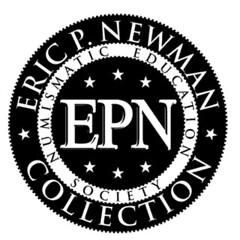 The Eric P. Newman Numismatic Education Society (EPNNES) announces the opening of the application
period for the 2024 Newman Grant program. Newman Grants are designed to financially assist
numismatic authors and organizations pursuing original research in American numismatics. This
program was launched in 2019 and supports research projects related to colonial numismatics, U.S.
federal coinage, counterfeit detection, and other areas.
The Eric P. Newman Numismatic Education Society (EPNNES) announces the opening of the application
period for the 2024 Newman Grant program. Newman Grants are designed to financially assist
numismatic authors and organizations pursuing original research in American numismatics. This
program was launched in 2019 and supports research projects related to colonial numismatics, U.S.
federal coinage, counterfeit detection, and other areas.
Authors, researchers, and numismatic organizations are encouraged to apply for amounts between $1,000 and $5,000. Awards may be applied toward related research costs including but not limited to photography, reproduction of research material and graphic art services, database access fees, and travel. Electronic publications will be preferred as EPNNES wishes to direct funds toward expenses specifically related to numismatic research, rather than the print publication of research. Newman Grant awardees agree to non-exclusive publication of their research on the Newman Numismatic Portal (NewmanPortal.org). EPNNES intends to make approximately half a dozen grants in 2024.
The Newman Grant program is administered for EPNNES by the Newman Numismatic Portal (NNP). Applications may be found on the Newman Numismatic Portal at https://nnp.wustl.edu/library/archivedetail/530553?Year=2024 and should be submitted to NNPCurator@wustl.edu. The application deadline is April 15, 2024, with the grant awards to be announced on May 25, 2024, coincident with the late Eric P. Newman's birthday.
It is the hope of EPNNES that this program will continue the legacy of Eric P. Newman in a way that would reflect his high standards for numismatic research.
VIDEO: BUST HALF COLLECTING
The David Lisot Video Library on the Newman Numismatic Portal can be found at:
https://nnp.wustl.edu/library/multimediadetail/522852
We highlight one of his videos each week in The E-Sylum. Here's one from 1995 about Bust Half Collecting, with three great talks in one program. -Editor
Bust Half Collecting for the Serious Collector
This literal pantheon of top numismatists discusses the more esoteric aspects of collecting Bust half dollars covering such topics as, Bust Half Dollar Die State Studies, Multi-Struck Bust Halves, and Pictorial Attribution Technique of Bust Halves. Brad Karoleff discusses new areas of investigation for Bust half die marriages and explains the value of a good reference library. David Finkelstein talks about the hair curls on the coins of 1812 in die emission sequence and what other information can be determined. Glenn Peterson gives a quiz on die varieties using examples of the most prominent and desirable coins. He explains why Overton is not always the best source for identification. This tape is a must for any advanced collector. Lecture with slides.
Speaker(s): Brad Karoleff, Dave Finkelstein, & Dr. Glenn Peterson.
To watch the complete video, see:
Bust Half Collecting for the Serious Collector
(https://nnp.wustl.edu/library/book/560337)
PNG 2024 ANA SUMMER SEMINAR SCHOLARSHIPS
Young numismatists are invited to apply for Professional Numismatists Guild scholarships to the 2024 ANA Summer Seminar. -Editor
 The Professional Numismatists Guild (www.PNGdealers.org) again will provide a scholarship to a deserving young numismatist (YN) to attend one of the four-day sessions of the American Numismatic Association (www.money.org) 2024 Summer Seminar in Colorado Springs, Colorado.
The Professional Numismatists Guild (www.PNGdealers.org) again will provide a scholarship to a deserving young numismatist (YN) to attend one of the four-day sessions of the American Numismatic Association (www.money.org) 2024 Summer Seminar in Colorado Springs, Colorado.
We are delighted to continue our long tradition of providing a YN scholarship for the popular, annual ANA educational programs. The PNG scholarship will cover airfare, tuition for one of the two 2024 Summer Seminar sessions, meals, and dormitory accommodations on the campus of Colorado College, adjacent to the ANA headquarters,
said PNG Executive Director John Feigenbaum.
All young numismatists between the ages of 13 and 22 are eligible to enter and are cordially invited to apply for the scholarship, but time is short. Entrants must submit a short essay outlining why they should be chosen as this year's scholarship recipient. The deadline for receipt of the entries is Friday, March 29, 2024,
explained Feigenbaum.
Entries must include the applicant's name and contact information. The essays can be sent by email to info@PNGdealers.org or by mail to the PNG Executive Director, 27890 Clinton Keith Rd., Suite D141, Murrieta CA 92562.
The two separate ANA Summer Seminar four-day sessions will be held from Sunday, June 16, to Wednesday, June 19, and from Sunday, June 23, to Wednesday, June 26, 2024. Participants ranging from teenagers to seniors take class instruction on specific coin and paper money collecting topics or the hobby's technical and business aspects.
Additional information about the ANA Summer Seminar can be found on the ANA website at www.money.org/summer-seminar.
The PNG is a nonprofit organization composed of many of the top rare coin and paper money dealers in the United States and four other countries. PNG member-dealers must adhere to a strict Code of Ethics in the buying and selling of numismatic merchandise.
For additional information about PNG or the young numismatists scholarship program, visit online at www.PNGdealers.org or call (951) 587-8300.
PORTRAIT LATHE MAKER CLAUDE CONTAMIN
Julia Casey researched a detail mentioned in last week's article on pantographs, the machine used to reduce artist designs for making coins. -Editor
The Identity of Contamin, maker of the U.S. Mint's Portrait Lathe
In last week's E-Sylum, Contamin
is mentioned as a maker of a pantograph engraving machine obtained from France and used by the US Mint in the 1830s. Contamin's first name and other details about him are indicated to be unknown. I decided to see if I could determine more information about Contamin. I did some digging and then independently came up with the same possibility, which David Powell wrote about in the March 22, 2020, E-Sylum - perhaps Contamin is Vincent Contamin, and this Contamin was the individual who later invented and sold piano chairs.
I dug deeper to find direct evidence of this hypothesis and now feel confident that Contamin of the pantograph fame is not Vincent Contamin, but Claude Contamin (1806-1876) and that he is indeed the same person who sold piano chairs.
In the 1844 Paris Exposition M. Contamin
was awarded a bronze medal for his piano stool design. The jury report states that (via Google translate): In the construction of a simple piano stool M Contamin was
able to show his ability as a mechanic, a capacity already well demonstrated in 1839 by the construction of a very good, perfected portrait lathe and which earned him a bronze medal.
After much searching, I was finally able to locate Contamin's first name in an 1842 French patent listing for a piano chair.
I also found a death notice for Claude Contamin on Ancestry.com that indicated he died in Paris at the age of 70, on March 29, 1876. He was described as a mécanicien,
and this is the same title Contamin gave himself in his advertisements and on the token discovered by David Powell.
One other piece of info I had to link the Portrait Lathe Contamin to the Piano Chair Contamin is in the 1842 France business almanac Contamin is listed with the address of 14 rue Salle au Comte, as a mécanicien and also a maker of a "Tour à portrait." This is the same address listed in his ad for piano chairs.
The A in the circle symbol indicates he won a silver medal.
At my request Steve Bishop searched world patent databases for records of Contamin's British patents, but so far he and Julia have come up empty. -Editor
Julia adds:
"Some of the British patents are accessible online but it is very scattershot. While I'd love to have the patents, I feel confident that Claude Contamin is our man."
Great discovery! Many thanks to Julia, Steve, David, Robert Whitehead, and Dick Johnson for their efforts now and over the years. We'd be grateful if any readers can locate additional new evidence to confirm or refute this finding. -Editor
To read the original 1844 Paris Exposition report, see:
Rapport du Jury central ...
1844
To read the earlier E-Sylum articles, see:
NOTES FROM E-SYLUM READERS: MARCH 22, 2020 : Vincent Contamin, Contamin Pantograph Inventor?
(https://www.coinbooks.org/v23/esylum_v23n12a16.html)
REDUCTION MACHINES AT THE U.S. MINT
(https://www.coinbooks.org/v23/esylum_v23n11a13.html)
VOCABULARY TERM: PANTOGRAPH, PART TWO
(https://www.coinbooks.org/v27/esylum_v27n03a10.html)
NOTES FROM E-SYLUM READERS: JANUARY 28, 2024
Tom Caldwell's Work as a Mentor
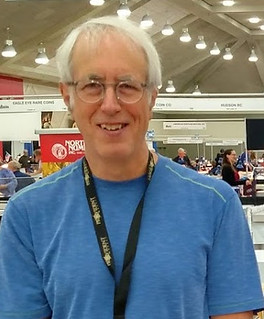 James Ricks of Atlas Numismatics writes:
James Ricks of Atlas Numismatics writes:
"I wanted to mention how important Tom Caldwell's work as a mentor has been to many apprentice and advanced numismatists-- I started working for Tom at 13 and continued for several decades. He is a generous and kind teacher but not without a sharp quip when he observes foolishness or confusion; Tom doesn't drink coffee but I suggest you have some before debating him!
Other numismatists who have worked with Tom include: Tom Culhane of The Elusive Spondulix (very sadly deceased); Jeff Kierstead (Jeff Kierstead Rare Coins); Tom's brother-in-law Barry McCarthy; Lano Balolescu; probably many more I have forgotten."
To read the earlier E-Sylum articles, see:
TOM CALDWELL INTERVIEW, PART ONE
(https://www.coinbooks.org/v26/esylum_v26n53a15.html)
TOM CALDWELL INTERVIEW, PART TWO
(https://www.coinbooks.org/v27/esylum_v27n01a16.html)
TOM CALDWELL INTERVIEW, PART THREE
(https://www.coinbooks.org/v27/esylum_v27n02a14.html)
TOM CALDWELL INTERVIEW, PART FOUR
(https://www.coinbooks.org/v27/esylum_v27n03a12.html)
John Adams Remembers Peter Mitchell
 John Adams writes:
John Adams writes:
"The piece on Peter Mitchell evoked many memories - all of them of the happy variety. Back in the day, Baldwin's 'Basement' contained a cornucopia of unloved Americana. John Ford had carried off the best of it, but there was still plenty left when I arrived on the scene, including perhaps 100 filthy dirty Admiral Vernon medals. I struck a deal with Peter - I would clean and attribute the Vernons in return for getting my pick. This arrangement worked out well for both of us, putting a large chunk of medals back into numismatic circulation, saved from a slow death of rotting away. Peter was a gentleman's gentleman with manners to match - at the same time, he knew his stuff."
To read the earlier E-Sylum article, see:
PETER DAVID MITCHELL (1933-2024)
(https://www.coinbooks.org/v27/esylum_v27n03a04.html)
Fred Holabird Remembers Rex Stark
In an email to clients this week, Fred Holabird wrote about the late Rex Stark:
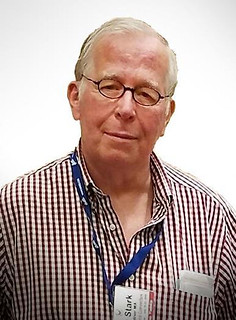 "Rex was known to virtually every major dealer/collector of Americana, especially political Americana. A profoundly knowledgeable man with a booming deep masculine voice, Rex was a main-stay in the Americana business. Rex was always present at the major shows, particularly in the late 1970s and 1980s when I first met him. As I recall, hopefully correctly, he had attended Stanford, then had a major change of heart on what he wanted to do in life. Rex was one of many who would always be available for questions involving his expertise, and we often spoke in this regard, particularly because I was in the center of the Americana business in the West, and he in the East, which offered a completely different insight and experience. His depth of knowledge was fantastic, and I'm afraid is unduplicated today. His catalogs always carried something of interest to everyone. The trick was calling the second you spotted it in the catalog, or it would be
"Rex was known to virtually every major dealer/collector of Americana, especially political Americana. A profoundly knowledgeable man with a booming deep masculine voice, Rex was a main-stay in the Americana business. Rex was always present at the major shows, particularly in the late 1970s and 1980s when I first met him. As I recall, hopefully correctly, he had attended Stanford, then had a major change of heart on what he wanted to do in life. Rex was one of many who would always be available for questions involving his expertise, and we often spoke in this regard, particularly because I was in the center of the Americana business in the West, and he in the East, which offered a completely different insight and experience. His depth of knowledge was fantastic, and I'm afraid is unduplicated today. His catalogs always carried something of interest to everyone. The trick was calling the second you spotted it in the catalog, or it would be sold.
RIP Rex."
To read the earlier E-Sylum article, see:
REXFORD ADDISON STARK (1947-2023)
(https://www.coinbooks.org/v26/esylum_v26n52a06.html)
Missouri Numismatic Society DANSCO Album
Chris Sutter writes:
"I saw a story by Justin Hinh and his Dansco album project. I looked at his walkthrough and did not see any specialty
albums like the one I have and I was curious if he had this album. I do not know when or why this album was made. I was offered it several years ago because of my interest in the Missouri Numismatic Society."
Justin writes:
"Nice find! I was not aware of this album. The front font is different than Dansco's typical font. The only other time I've seen an album with a similar font was a custom-made Canada small cents album with the owner's name printed on it."
Interesting item. Are readers aware of any other such customized albums? -Editor
To read the earlier E-Sylum article, see:
DANSCO LIBRARY AND PRESERVATION UPDATE
(https://www.coinbooks.org/v27/esylum_v27n03a09.html)
More on the 1899 Peru Counterfeit Dinero
"I hope some real numismatist familiar with this series writes an article about this coin. The elemental analysis is critical and conclusive that the coin is fake. But I'd also like to see the stats on diameter and weight, plus a side by side comparison of the physical features.
"I found a photo of a high-grade 1898 dinero in a PCGS slab to use as a comparison piece with the fake 1899.
"To my eye, there are several inconsistencies:
"1. The lettering is of poor quality on the fake, and the words FIRME Y FELIZ all seem to run together.
"2. The figure of Liberty seems to have a hair bun on the fake piece.
"3. The area in exergue appears distinctly different on the two pieces.
"I'm sure we'll hear more about this."
Arthur Shippee writes:
"Differences — also in wear: how can the lettering of Libertad in the column be so worn away, when the other lettering is relatively sharp? The wear patterns look wrong.
"In the DINo at the bottom, the fake's o seems wrong, too.
"One would have to make a lot of these for them to be worth it, right? I wonder how many were recognized as fakes?"
Bob responds:
"I agree on wear and DINo. An expert might opine that the apparent wear on the fake is actually just the result of an incomplete impression from a cast. I'm not smart enough to know.
"My guess is that many of these were produced, but it's only a guess. I do remember from my time living in the UK, something like 2.5% - 3% of the one-pound coins in circulation were fakes. An astounding number."
Thanks! See the article elsewhere in this issue about the Anti-Counterfeiting Educational Foundation. -Editor
To read the earlier E-Sylum article, see:
THE COIN THAT SHOULDN'T EXIST
(https://www.coinbooks.org/v27/esylum_v27n01a20.html)
San Francisco Municipal Railroad Tokens
Thomas Lovelace writes:
"I was going through my transportation token collection and found a bunch of San Francisco municipal railroad tokens. I took them to San Francisco and used them on the buses and streetcars. I am wondering if this is the only place in the world where a streetcar token can still be used on a streetcar. The fare machines accept them for the full fare of $3."
Wow - that's great to hear. Are readers aware of any other transportation systems that still accept their old tokens? How many even still issue and sell tokens? -Editor
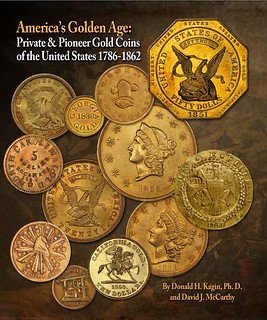 Video: America's Golden Age
Video: America's Golden Age
Michael Wehner of the Pacific Coast Numismatic Society writes:
"Our latest PCNS presentation could be of interest to some readers. It is long however at 1 hour 47 minutes."
America's Golden Age: Private and Pioneer Gold Coins 1786–1862
by Dr. Donald Kagin & David McCarthy
Don and David take us on a tour of pioneer gold coins via timeline as detailed in their new book.
To watch the video, see:
America's Golden Era: Private and Pioneer Gold Coins 1786–1862 by Dr. Donald Kagin & David McCarthy
(https://www.youtube.com/watch?v=azTp7le0t8I)
Mint Packing Slip Snafu
Steve Rush writes:
"Last Friday, 1/19/24, I received from the U.S. Mint the 2024 W Proof American Silver Eagle I had ordered. The box had my name/address on it. Upon inspection found the coin was beautiful, however, the packing slip was for a person residing in Mechanicville, NY. I live in Missouri.
"Immediately sent an email to the mint complaining someone likely received their coin with a packing slip with my name and address on it. Not a happy thought!
"Mint's response was my complaint has been referred to upper management. The rest of the response gave me an update on my order (obviously I got it), instructions on how to check the order status, and the rest of the standard verbiage.
"Just wanted to share my unpleasant experience in case others don't look at the packing slip."
FANTASY BANK BAGS FOR SALE
In the January 22, 2024 issue of the Journal of the Old Bag Collectors Club, Editor Pete Smith discusses fantasy bank bags for sale on eBay. -Editor
 As an indication of the popularity of bag collecting, promoters have started to produce fantasy bags for sale on eBay. Shown on this page are bags for the Carson City Mint, Bank of Tombstone, Arizona, and Bank of Virginia City.
As an indication of the popularity of bag collecting, promoters have started to produce fantasy bags for sale on eBay. Shown on this page are bags for the Carson City Mint, Bank of Tombstone, Arizona, and Bank of Virginia City.
The seller claims, These are Printed on Authentic Bank Money Bags 9" wide and 17" tall and are made of Natural Heavy Duty Canvas with Tie Straps.
What does it mean that they are printed on Authentic Bank Money Bags
? It means they bought the same unprinted canvas bags that anyone can buy from various vendors. These are fantasy designs meaning they have not reproduced actual designs used by these banks.
To read the complete issue on the Newman Portal, see:
Journal of the Old Bag Collectors Club
Vol. II, no. 1. Edited by Pete Smith.
(https://nnp.wustl.edu/library/publisherdetail/549372?Year=2024&displayAmt=50)
VOCABULARY TERM: PAPERWEIGHT
Here's another entry from Dick Johnson's Encyclopedia of Coin and Medal Terminology. -Editor
Paperweight. A medallic item intended for use on desktops to hold down paper. Usually fairly heavy in weight and large size, metal paperweights sometimes have half-ball or square feet (2 to 4) on the reverse. Or, if no feet, paperweights often have a felt backing. Often medallic paperweights are uniface, and if they are unusual shape they do not have sharp corners (and often have rounded edges). A large paperweight – always a medallion – is called a letterweight. Since any large medallic item could be used to hold down papers, a paperweight is usually not designated as such unless intended in some way. Thus the reverse feet or felt backing are often the only characteristic of a purely paperweight item. See half ball feet.
Some glass paperweights have a medallic connection in that medals were used as their model. Called sulphides, these objects usually contained the portraits or other devices modeled from the bas-relief medal design. Only infrequently did their makers include the lettering. Collectors and museum curators like to match up the medal and the sulphide or paperweight to display together (as an associated item).
To read the complete entry on the Newman Numismatic Portal, see:
Paperweight
(https://nnp.wustl.edu/library/dictionarydetail/516456)
WILLIAM SUMNER APPLETON (1840-1903)
E-Sylum Feature Writer and American Numismatic Biographies author Pete Smith submitted this article on Boston numismatist William Sumner Appleton. Thank you. -Editor
Last week I read a book; this week I read a periodical. The item was Memoir of William
Sumner Appleton, A.M.
by Charles C. Smith in Proceedings of the Massachusetts Historical
Society, Volume XXXVII, Oct. 1903, pages 516-527. Here are some excerpts:
WILLIAM SUMNER APPLETON was born in Boston January 11, 1840, and died in his native
city April 28, 1903. He was the elder son of the Hon. Nathan Appleton, for nearly thirty years a
member of this Society, and for three sessions a Representative in Congress from the Boston
district, by his second wife, Harriet Coffin, daughter of Jeffrey Sumner, of Boston.
As a small boy he was sent to a boarding school at Jamaica Plain, then kept by Mr. Cornelious
M. Vinson, which had enjoyed a wide reputation under the management of Mr. Charles W.
Greene, its first principal. He was fitted for college in the private Latin School of Mr. Epes S.
Dixwell, who had recently resigned the headmastership of the Boston Latin School, and who was
the most eminent classical teacher in this community. The thoroughness of his preparation was
seen in his high rank in the first three years of his college course. He graduated in 1860 in the
first half of his class, being entitled to a part at Commencement, a disquisition on
A Uniform Coinage.
In the year in which he graduated he was one of the founders of the Boston Numismatic
Society, and he was its secretary from that time until his death.
In his early years he was fond of dancing and social life. From 1864 to 1871 he was a member
of the Independent Corps of Cadets, and for the last four years was in command of a company,
with the rank of first lieutenant.
His interest in coins and medals dates back to his boyhood, and is mentioned in some of his
earliest letters. This study never lost its attractiveness to him, and was pursued to the end of his
life. At his death his collection, which was remarkable both for the beauty and the rarity of its
specimens, included about twelve thousand coins and three thousand medals, the greater part of
which he himself catalogued with great minuteness. Besides being one of the original members
of the Numismatic Society, he was one of the Publishing Committee of the American Journal of
Numismatics from 1870 to 1891, and made many short communications to it.
Inheriting from his father, who died in 1861, and his mother, who died in 1867, an ample
fortune, he had no need to pursue any gainful profession; but he nevertheless entered the
Cambridge Law School, and graduated in July, 1865, with the degree of L.L. B.
In 1867, at the early age of twenty-seven, he was honored with an appointment as one of the
commissioners to attend the annual assay at the United States Mint.
4
August 12, 1871, he was married, at the United States Legation in Berne, Switzerland, to Edith
Stuart, daughter of his cousin William Stuart Appleton, of Baltimore, Maryland. His eldest child,
a daughter, was born in Paris before his return to Boston.
An ineffective delivery and an indistinctness of speech, especially in his later years, detracted
much from the interest with which his papers and remarks were listened to; but their value was at
once seen when written out in his clear and beautiful handwriting or transferred to the printed
page.
by his last will, dated April 25, 1902, Mr. Appleton gave … a very valuable and important part
of his collection of medals and coins to the Historical Society; and … he directed the trustees
under his will to pay over specified sums to numerous literary, scientific, and charitable societies
or institutions, the first of which was this Society, and among the others were the American
Academy of Arts and Sciences and the New England Historic-Genealogical Society.
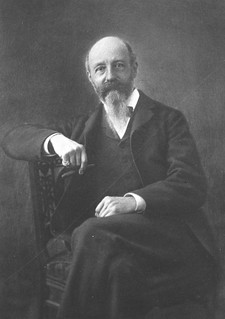 The published memoir includes an extensive description of six trips to Europe and of his many
publications on genealogy. I have always liked Appleton because of the charming portrait
published with the memoir. It was also published in the American Journal of Numismatics at
about the same time.
The published memoir includes an extensive description of six trips to Europe and of his many
publications on genealogy. I have always liked Appleton because of the charming portrait
published with the memoir. It was also published in the American Journal of Numismatics at
about the same time.
The first sale from his collection was conducted by Charles Steigerwalt on May 21, 1907. This was composed of Canadian and British coins and medals. The second sale was conducted by Steigerwalt on January 18, 1910. This included ancient Greek, Roman and Egyptian coins. Lot 232 was a collection of 259 coins from Alexandria. Lot 259 was a collection of 247 Roman Family Denarii.
Thomas Elder sold coins and medals from Appleton in his 81st sale on July 8 & 9, 1913. The sale began with a long run of world medals including strong groups of the medals of Luther and of Napoleon. It is unfortunate that Appleton did not leave a journal of his travels and records of his purchases. The collection shows what could be acquired by someone with free time, unlimited funds and a love of the cultural articles of history.
When Thomas Elder promoted his auction of the Appleton library, he stated This collection of
Books is the largest ever offered in the United States.
The sale was conducted May 10, 1913,
with 414 lots. Many lots of periodicals were sold in group lots.
The Massachusetts Historical Society did not have adequate resources to provide security for the coins and to make them available for research. Some had gone missing by 1920. Eventually they put the coins in a bank vault where they were not available to anyone. The coins were consigned to Stack's for a series of six auctions conducted over 1970 to 1976.
Samuel Appleton appears on a medal struck at the U. S. Mint for the Massachusetts Historical Society. (Julian AM-43) Samuel Appleton was the uncle of William Sumner Appleton.
CANADA'S SNOWFLAKE PHOTOGRAPHER
Local news publications are great sources for additional background on coin designs and artists. Here's a story about the photographer behind the snowflake on a new Canadian coin. -Editor
 What's more Canadian than a snowflake?
What's more Canadian than a snowflake?
Don Komarechka reflects that sentiment as an artist on the new $20 Canadian coin, which is as unique as a snowflake.
The pure silver hexagon coin with crystal features the former Barrie resident's stellar dendrite (tree-like) snowflake on one side, and the effigy of Queen Elizabeth II, by Susanna Blunt, on the other.
I think that seeing a snowflake … those times you look out on the yard or the lake and you can see it's glistening, it's sparkling a little bit … to know that every one of those little sparkles is something as unbelievably beautiful as what is on that coin,
Komarechka said.
It's the Royal Canadian Mint's first hexagon coin and features a sparkling snow crystal.
Komarechka — who now lives in Bulgaria with his wife, Desislava, and their seven-year-old daughter, Danika — bills himself as a nature, macro and landscape photographer.
His snowflakes have graced two other Canadian coins, one issued in 2017 and the other in 2018.
 And it began in Barrie, where almost all of his snowflake photos have been taken.
And it began in Barrie, where almost all of his snowflake photos have been taken.
Originally from Sudbury, Komarechka spent his formative years in Barrie after high school, is a former president of Barrie Photo Club and has sat on its executive.
The actual gear kind of makes you feel like you're holding a microscope outside. It's all done hand-held,
he said. You get to see all the shadows and all the textures among the surface (of the snowflake), which makes a great transition to an engraving on a coin."
To read the complete article, see:
'Unbelievably beautiful': Here's the story behind the snowflake on new $20 coin
(https://www.newmarkettoday.ca/local-news/unbelievably-beautiful-heres-the-story-behind-the-snowflake-on-new-20-coin-8102807)
THE BOOK BAZARRE
NEW LEADERSHIP AT ACEF
This press release announces new leadership at the Anti-Counterfeiting Educational Foundation. -Editor
Anti-Counterfeiting Educational Foundation elects new leaders
A new board of directors comprised of well-known and respected leaders in the numismatic community has been elected to guide the non-profit Anti-Counterfeiting Educational Foundation, Inc.
John Albanese is the new president. Officers serving with him include Barry Stuppler, vice president; Beth Deisher, secretary; and Ian Russell, treasurer. Also serving as directors are Don Bonser, John Dannreuther, Steve Ivy, David McCarthy, Mary Sauvain, Ute Wartenberg Kagan, Fred Weinberg, Reid Wolf, and Jack Young.
The new board took over the reins of responsibility Jan. 1.
Our new ACEF Board is committed to revitalizing the foundation's mission, which is to assist and
provide educational training to law enforcement at all levels who are seeking to combat the flow of
counterfeit coins and paper money entering the United States as well as to alert dealers, collectors, and
investors in the numismatic marketplace of the deceptive means counterfeiters are employing to entice
them to unknowingly purchase fakes,
Albanese said.
Albanese added: ACEF can't do this alone. We need the numismatic community's support. Our work is
funded entirely by donations.
Originally a task force working under the umbrella of the Industry Council for Tangible Assets in 2017, ACEF became a 501(3)(C) non-profit corporation with Public Charity status in 2018. From the fall of 2019 through December 2023 the Professional Numismatists Guild supplied administrative support to the foundation. Beginning in January 2024 ACEF is no longer dependent upon another organization for administrative support.
For news and informative articles as well as information on how to donate, visit ACEF's website: acefonline.org.
Counterfeiting and counterfeiting detection/prevention is a never-ending arms race. Counterfeiting technology gets better and better, and with the growth of online sales there are new victims every day. Certification services are well established, but the volume of counterfeits in the market is overwhelming and a law enforcement response is needed to slow or halt the flow. Authorities need all the help and education they can get, and it makes sense for the numismatic community to be proactive and offer its assistance. Please help with your donations, and encourage your numismatic colleagues to do the same. -Editor
REPLACE PUNXSUTAWNEY PHIL WITH A COIN?
In the shameless-random-piggyback-publicity-seeking-press-release department, here's a proposal from People for the Ethical Treatment of Animals to replace everyone's favorite weather-prognosticating Groundhog with a coin toss. -Editor
PETA is offering to send a giant gold coin to replace Punxsutawney Phil.
The animal rights organization wrote a letter to The Punxsutawney Groundhog Club's president saying they'd send a giant coin in exchange for Phil's release to a reputable sanctuary.
Using multiple coin toss puns, PETA President Ingrid Newkirk points out in her letter that Phil's predictions are correct about 40% of the time, so flipping a coin would give a more accurate forecast.
"Groundhogs can't make heads or tails of the weather forecast and shouldn't be jostled around by large members of a different species and thrust in front of noisy crowds for a photo op," Newkirk said in a news release. "PETA is urging The Punxsutawney Groundhog Club to send Phil to a reputable sanctuary that will give him the care he needs and not to treat him as a wildlife prop."
PETA calls Groundhog Day inhumane, saying groundhogs are highly intelligent animals that enjoy burrowing, exploring and hibernating -- activities Phil can't do in the small enclosure where he's kept.
To read the complete article, see:
PETA offers to replace Punxsutawney Phil with giant gold coin
(https://www.cbsnews.com/pittsburgh/news/peta-replace-punxsutawney-phil-giant-coin-groundhog-day/)
This offer is not the first time PETA has tried to replace Phil. Previous offers from the organization included a human replacement for Phil, who would live in his small enclosure and take his place making unscientific weather predictions, and planting a persimmon tree, whose seeds are believed by some farmers to indicate the weather ahead. PETA says both of those offers still stand, alongside their new coin offer.
Groundhog Day is on February 2, 2024.
To read the complete article, see:
PETA Wants to Replace Punxsutawney Phil with a Giant Gold Coin
(https://phl17.com/phl17-news/peta-wants-to-replace-punxsutawney-phil-with-a-giant-gold-coin/)
CLEMENTE COMMEMORATIVE COIN CONSIDERED
As a Pittsburgh native and youthful Pirates baseball fan, I was glad to see that Hall of Famer Roberto Clemente is being considered as a commemorative coin subject. I'm old enough to have seen him play at Three Rivers Stadium before his untimely death in 1972. -Editor
 Pittsburgh Pirates great Roberto Clemente may be honored on a commemorative coin if a measure currently before Congress is approved.
Pittsburgh Pirates great Roberto Clemente may be honored on a commemorative coin if a measure currently before Congress is approved.
U.S. Rep. Adriano Espaillat, D-New York, joined local Reps. Chris Deluzio and Guy Reschenthaler in introducing legislation that would require the secretary of the treasury to mint commemorative coins honoring the legendary baseball star.
The Hall of Famer was described in the bill as a legend in life and death, a baseball star, a humanitarian activist, and a symbol of Latin American pride.
Roberto Clemente Jr. told TribLive news partner WTAE that Espaillat, the bill's primary sponsor, is a big fan
of Clemente.
We're very happy that he did make the move, and we're hoping that it will pass, and I think it will,
he said.
If Congress approves the measure, the treasury will mint $5 gold coins, $1 silver coins and half-dollar coins bearing a depiction of Clemente. The designs would need to be approved by Clemente's living family members, as well as the Roberto Clemente Foundation and the Commission of Fine Arts.
To read the complete article, see:
Congress considers commemorative coin honoring Roberto Clemente
(https://triblive.com/sports/congress-considers-minting-commemorative-coin-in-honor-of-roberto-clemente/)
But proposed legislation is a long way from reality - it takes a literal Act of Congress to authorize commemorative coinage, and there are limited opportunities and a great number of competing proposals. As this Coin World article by Paul Gilkes notes, over 50 such bills are seeking approval, with proposed honorees including the United States Colored Troops, World War II Nurses, Muhammad Ali, and Billie Jean King. -Editor
To read the complete article, see:
Congressional medal legislation awaiting possible action
(https://www.coinworld.com/news/us-coins/congressional-medal-legislation-awaiting-possible-action)
NUMISMATIC NUGGETS: JANUARY 28, 2024
Here's a selection of interesting or unusual items I came across in the marketplace this week. Tell us what you think of some of these. -Editor
1797 Capped Bust Right Eagle
The mintage for the 1797 Small Eagle provided in most numismatic references is 3,615 coins, based on Walter Breen's 1988 assertion that the 3,615 eagles delivered from March 25 through May 2, 1797, were of this issue. Based on a more exhaustive study of die states, emission sequences, and coins extant, John W. Dannreuther provides an estimated mintage of 1,250 to 3,615 coins for the 1797 Small Eagle in his 2006 early gold coin reference. The 1797 is the scarcest date in the Capped Bust Right, Small Eagle ten-dollar gold series of 1795 to 1797. At least one 1796 is known to have been struck after all known 1797 Small Eagle coins, a conclusion based on the presence of a reverse die crack from the border through the right side of the letter O in OF to the wreath. Whether a remarriage for the 1797 Small Eagle is also known is pending discovery of an example of this date with that reverse die crack. Sure to be a highlight of a highly regarded numismatic cabinet, this piece comes highly recommended.
A fixed price offering from Stack's Bowers. Nice coin. -Editor
To read the complete item description, see:
1797 Capped Bust Right Eagle. Small Eagle. BD-1, Taraszka-7. Rarity-5. AU-58 (PCGS).
(https://stacksbowers.com/product/1797-capped-bust-right-eagle-small-eagle-bd-1-taraszka-7-rarity-5-au-58-pcgs/)
1862 $50 Virginia Treasury Note
1862 Cr.7 $50 Virginia Treasury Richmond VA Obsolete Banknote PCGS CAU55 PPQ
A nice Civil War item. -Editor
To read the complete lot description, see:
1862 Cr.7 $50 Virginia Treasury Richmond VA Obsolete Banknote PCGS CAU55 PPQ
(https://www.ebay.com/itm/155289564878)
1933 George V 'Wreath' Crown
George V (1910-36),0.500 silver Wreath Type Crown, 1933, bare head left, BM raised on truncation for engraver Bertram Mackennal, Latin legend and toothed border surrounding, GEORGIVS V DEI GRA: BRITT: OMN: REX,rev.Imperial crown, date above, emblematic wreath surrounding of roses, shamrocks and thistles, small K.G. to right of lowest rose for engraver Kruger Gray, denomination in words at bottom, Latin legend surrounding, .FID. .DEF. .IND. .IMP., weight 28.27g (Bull 3644; ESC 374 R2; Davies 1636; S.4036).Toned with usual touch of wear to high points and abrasion on cheek, otherwise extremely fine.
Mintage 7,132 struck.
The legends translate across both sides of these denominations as "George the Fifth by the grace of God, King of all the Britains, Defender of the Faith, Emperor of India."
The Wreath Crown design by Kruger Gray was much admired and the type design continued in succeeding years at the request of the Bank of England who liked to stock them at Christmas time to present to good clients, hence why the mintages were always quite small for the normal currency pieces. Bertram Mackennal (later knighted) was the Australian engraver responsible for the obverse design.
Nice coin from the online stock of Sovereign Rarities. -Editor
To read the complete item description, see:
George V 1933 'Wreath' Crown, mintage 7,132 struck for Christmas 1933
(https://www.sovr.co.uk/products/george-v-1933-wreath-crown-mintage-7132-struck-for-christmas-1933-hm32991)
1933 Chicago Worlds Fair Jewish Day Token
1933 Chicago Illinois Worlds Fair Souvenir Token. 1933 Jewish Day Chicago A Century Of Progress. The Romance Of A People.
Interesting token. and not one I recall seeing before. From the eBay offerings of Steve Hayden. -Editor
To read the complete lot description, see:
1933 Chicago Illinois Worlds Fair Token Jewish Day Hebrew Star Of David Moses
(https://www.ebay.com/itm/386649708586)
Anti-Semitic Over-printed Banknote
Third Reich Anti-Semitic over-printed inflation banknote.
No words for this one. -Editor
To read the complete lot description, see:
Third Reich Anti-Semitic over-printed inflation banknote. UK...
(https://www.easyliveauction.com/catalogue/lot/
a9b1f3a89934336619347f4ada49f796/0af8d24542e81eb9357e7ef448a6646f/
warrington-northwich-auction-lot-2100/)
COINS OF THE GALLIC EMPERORS
In my Diary last week I mentioned getting a preview of Mike Markowitz' upcoming article for CoinWeek on coins of the Gallic Emperors. It's been published, and here's an excerpt. See the complete article online for more. -Editor
FOR FOURTEEN YEARS during the late third century (260 – 274 CE), the western provinces of the Roman Empire maintained a separate state independent of Rome. Rulers of this so-called Gallic Empire
issued coinage that was often of better metal and workmanship than Rome was producing.
In the Spring of 260, the Sassanian Persian ruler Shapur I disastrously defeated the Roman emperor Valerian in battle. When this news reached the legions on the Rhine frontier, they proclaimed Postumus, the military governor of the German provinces, as emperor, in opposition to Valerian's son, Gallienus.
Postumus
Postumus, 261 CE, Treveri Mint. AV Aureus. Image: British Museum.
Preoccupied with threats in the East, Gallienus lacked the strength to fight Postumus and reluctantly accepted his breakaway empire. A capable administrator, Postumus organized his regime on classic Roman lines, with its own Senate and an extensive coinage of gold aurei (73 types), alloy antoniniani (108 types; often described as radiates
because of the radiant spiked crown on the imperial portrait) and bronze sestertii (73 types).
Frequently reproduced (for example, on the dust jacket of David Sear's Roman Coins and Their Values, Volume III) a unique gold aureus of Postumus bears a remarkably sensitive facing head of the emperor, turned slightly to the left, work of a talented master engraver. Gifted to the British Museum in 1864 by the collector Edward Wigan (1823-1871) this coin is described as the finest portrait executed on a Roman coin in the 3rd century.
The reverse, evidently the work of a less skilled hand (reverse dies wore out more quickly, and were often assigned to apprentices), shows the emperor seated, with a Latin inscription celebrating the dutiful generosity of emperor Postumus.
This was probably a special issue intended for distribution to officers and members of the elite. The coin was crudely pierced in antiquity.
Postumus, 260 – 269 Aureus, Cologne 261. Image: NAC.
Another very rare gold aureus struck at Köln, bears a more conventional profile portrait wearing a laurel wreath. On the reverse are three heads of the sun god Sol, wearing his signature radiate
crown. This may represent the three provinces of Roman Gaul: Belgica, Lugdunensis, and Aquitania. The simple inscription is AETERNITAS (Eternity
).
To read the complete article, see:
Breakaway Empire: Coins of the Gallic Emperors
(https://coinweek.com/breakaway-empire-coins-of-the-gallic-emperors/)
To read the earlier E-Sylum article, see:
WAYNE'S NUMISMATIC DIARY JANUARY 21, 2024
(https://www.coinbooks.org/v27/esylum_v27n03a20.html)
WASHINGTON BEFORE BOSTON MEDAL
This new Stack's Bowers Coin Resource Center entry discusses the famous Washington Before Boston medal. Here are two excerpts - the first describes the valiant efforts of Washington's engineer (and professional bookseller) Henry Knox. -Editor
Fort Ticonderoga, on the west bank of Lake Champlain, was taken by American forces under Ethan Allen and Benedict Arnold in May 1775. Once Washington began assembling his plans to push the British out of Boston, it became evident that the 59 British cannons captured at Ticonderoga represented the nearest American-held artillery - and those cannons were 300 miles away.
Fortunately, Washington's army included an amateur engineer (and professional bookseller) from Boston named Henry Knox, who had familiarized himself with fortifications and cannon during the early days of the campaign. Knox, just 25 years old, impressed Washington enough that the General gave Knox command of an expedition to deliver the guns of Ticonderoga to Boston. Knox left on November 17, 1775, and arrived at Fort Ticonderoga on December 5. The winter weather was brutal on Washington's troops, but welcome beneath the oxen hooves and the sleighs that Knox used to carry 60 tons of iron eastward. Knox took the guns south to Albany, then east to Boston, arriving in Cambridge on January 27, 1776.
The cannon were not originally intended for Dorchester Heights, a high ground that looked down on Boston from the south, but that's where they ended up - and they ended up there all in one night. Under cover of darkness, with the view somewhat blocked by hay bales and other temporary fortifications, Washington's men humped the big guns to the top of the Heights. On the morning of March 5, the British forces awoke to an unimaginable sight: the high ground fortified, the guns of Ticonderoga looming, and their own position under grave threat. Washington had overseen the seemingly impossible, and made the dug-in occupation of the British in Boston indefensible. The British commander on the scene, General William Howe, is supposed to have said "My God, these fellows have done more work in one night than I could make my army do in three months."
When the British artillery erupted on the night of March 9, it was clear to all present that the noisy cannonade was a cover for evacuation. It took ten days for the entire occupation force to leave. After they left, it took Congress less than a week to vote to award their very first ever medal to the man who oversaw the bloodless triumph that saved Boston.
By rights, this medal could just as easily depict the stout Henry Knox, whose image is measurably less easy on the eyes than Antoine Houdon's elegant bust of the godlike Washington. While Washington conceived the plan for the siege of Boston, only Knox's dashing-through-the-snow derring-do enabled the Commander-in-Chief to push Howe's army out to sea.
And here's some information on the design and production of the medal. -Editor
Du Simitière produced a nice design and was paid for it by the Continental Congress. It was never produced. As Congress moved on to prosecuting a full-fledged war against the most powerful nation on the planet, Washington's medal was back-burnered by every committee assigned to it. Eventually, Benjamin Franklin, serving as the minister plenipotentiary to France, was asked to help in September 1779. Franklin dropped the ball, succeeding in obtaining only De Fleury's medal for Stony Point and his pet medallic project, the Libertas Americana medal. Time passed, and David Humphreys was asked to pick the medal project back up in the summer of 1784. He arrived in Paris soon thereafter, set to work, and by the spring of 1785 had successfully nailed down designs and inscriptions from the Academie des Inscriptions et Belles-Lettres in Paris. Washington's medal, along with those for Horatio Gates and Nathanael Greene, was finally coming along.
Humphreys wrote to Washington with an update on May 10, 1785, describing the designs and inscriptions the medal would feature. "I think it has the character of simplicity & dignity which is to be aimed at in a memorial of this kind, which is designed to transmit the remembrance of a great event to posterity," Humphreys wrote, adding "you really do not know how much your name is venerated on this side the Atlantic." The next letter Humphreys sent to Washington from Paris, dated July 17, 1785, noted that "M. Houdon" was set "to depart for Mt Vernon" from Paris, with the help of Thomas Jefferson. Jean-Antoine Houdon and three assistant sculptors arrived at Mount Vernon on October 2, 1785 to produce a statue of Washington that had been commissioned by the state of Virginia. Houdon took a life mask during his two week stay, then returned to Paris to complete the project. Humphreys updated Jefferson on Washington's medal on January 30, 1786, noting "there is no obstacle to commencing the medal for Gen. Washington, since Houdon's return, etc."
While Humphreys apparently inquired with Augustin Dupre about accomplishing the Washington medal, the duty of executing the Houdon bust and other design elements fell to Benjamin Duvivier, who finally finished the dies in the spring of 1789. He was paid 3,600 livre tournois, more than twice the sum he received for the Cowpens medals for Howard and William Washington, and more than the 2,400 livre tournois Dupre was paid for each of the medals to be given to Daniel Morgan and John Paul Jones. The completed gold Washington medal was displayed at the Salon of 1789 that summer in Paris, then hand carried to the United States by Thomas Jefferson in October 1789.
To read the complete entry, see:
Betts-542
1776 Washington Before Boston Medal
(https://stacksbowers.com/coin-resource-center/coin/betts-542-washington-before-boston/)
GOLD NOBEL PRIZE MEDAL EBAY FIND
It's pretty safe to say all numismatists dream of making that flea market find of a lifetime. How about a gold Nobel Prize medal on eBay? Also pretty safe to assume it's probably fake. Here's a listing I came across this week. -Editor
The Nobel Prize Medal in Physiology or Medicine RARE USA Swedish With Case
good gift for a young doctor
Weight : 1Oz, Size : 40mm, Base Material : Bronze.Gold Content : Heavily Gold Layered.Thickness : 3mm.The Nobel Prize in Physiology or Medicine 1962 was awarded jointly to Francis Harry Compton Crick, James Dewey Watson and Maurice Hugh Frederick Wilkins "for their discoveries concerning the molecular structure of nucleic acids and its significance for information transfer in living material."
This is a Gold Coin Commemorating the Nobel Prize Medal Awarded to their Discovery. The 1962 Nobel Prize for Physiology or Medicine awarded to Dr. Francis Harry Compton Crick, along with Drs. James Dewey Watson and Maurice Hugh Frederick Wilkins, for …their discoveries concerning the molecular structure of nucleic acids and its significance for information transfer in living material,
or what would become known as DNA, sold on April 11, 2013, for $2.27+ million (including Buyer's Premium) as the highlight of Heritage Auctions' Historical Manuscripts Signature Auction at the Fletcher-Sinclair Mansion. The discovery of the structure of DNA launched a scientific revolution and forever changed human understanding of life,
said Sandra Palomino, Director of Historical Manuscripts for Heritage Auctions. Crick's initials are engraved on the reverse of the medal, along with the year of the prize, 1962, presented in Roman numerals: F. H. C. Crick/MCMLXII.
So it's a "Gold Coin Commemorating the Nobel Prize Medal" and a "good gift for a young doctor." And it's bronze but "Heavily Gold Layered". It's not overpriced at $29 + shipping, and probably a fun toy to play with.
Back in March 2013 John Sallay notified us of the upcoming Heritage sale of the original Francis Crick gold Nobel Prize medal. Here are the images for comparison. -Editor
The difference in quality is like night and day - the eBay piece is laughable in comparison. But there are better gilt bronze examples. -Editor
John added:
"I have a gilt bronze version of this same Nobel Prize Medal in Physiology or Medicine of the Nobel Assembly at the Karolinska Institute, issued to one of the 1977 winners, Roslyn Yallow. I understand that these gilt medals were made available to the winners for display purposes, so they did not have to have their actual gold medals out on display or otherwise just lying around. Even those are pretty scarce items."
John kindly sent images of his gilt bronze medal. Thank you! -Editor
The eBay item is not one of the originally-issued gilt versions, which were struck from the same dies before being gilt. Now one of those would be a respectable eBay find. -Editor
John writes:
 "Speaking of respectable eBay finds, here are photos of a gilt bronze Nobel Prize in Chemistry, to Aaron Klug 1982 that I purchased on eBay in September. I am embarrassed to say what I paid, but it was indeed a great find at a great price. Both of these medals are stamped on the edge, MV BRONS and the date, 1977 or 1982. The MV stands for AB Myntverket, which produces the Swedish national coins and the Nobel Prize medals, and BRONS is Swedish for bronze, of course.
"Speaking of respectable eBay finds, here are photos of a gilt bronze Nobel Prize in Chemistry, to Aaron Klug 1982 that I purchased on eBay in September. I am embarrassed to say what I paid, but it was indeed a great find at a great price. Both of these medals are stamped on the edge, MV BRONS and the date, 1977 or 1982. The MV stands for AB Myntverket, which produces the Swedish national coins and the Nobel Prize medals, and BRONS is Swedish for bronze, of course.
Nobel laureates are allowed to order up to 3-5 examples (sources vary as to the exact number, which may have varied over the years) of these gilt bronze replicas of their original medal for family members and for display purposes at the organizations and/or the laureates' universities. These particular examples weigh 106 grams and 117 grams, respectively, versus the original gold medals at an average of about 175 grams. All are 66 mm in diameter, as they are made from the same dies in the same Swedish mint facilities. While the gilt bronze pieces should theoretically be more widely available than the gold originals, as a practical matter, the gold original medals seem to show up on the market more often. Nevertheless, while gold examples have been bringing in the seven figure price range depending on the fame and importance of the laureate's work, the gilt bronze medals (and the few bronze specimens made for collectors in 1902) tend to be four figure items when they show up at auction, so in that sense they are indeed more collectable
.
Plenty of information about the Nobel Prize and the medals is available online, most notably on the Nobel Prize organization's website,
https://www.nobelprize.org/ and a comprehensive Wikipedia article,
https://en.wikipedia.org/wiki/Nobel_Prize. Michael Wehner made an excellent presentation on The Nobel Prize and other medals of Erik Lindberg
to the Pacific Coast Numismatic Society in October 2022, which is available on YouTube at:
https://www.youtube.com/watch?v=vwQRNbB3KlQ. Also, in 2001 The Royal Coin Cabinet, Stockholm, published a book on Nobel Medals, The Royal Coin Cabinet,
by Lars O. Lagerqvist, though I believe this book is out of print and tough to find."
In his talk, Michael Wehner mentions having met Nobel prize winners. Here are the closest I've gotten. In 1980 my first job out of college was at Bell Laboratories in Holmdel, New Jersey. One time I attended a Halloween costume party and was later told, "the guy in the mummy costume? - that was Wilson of Penzias and Wilson", famed for their measurement of cosmic background radiation, evidence of the "Big Bang" that formed our universe. They had received the Nobel Prize in physics in 1978. Later I met artificial intelligence pioneer Herbert Simon when I attended a lecture of his at Carnegie-Mellon University. He received the Nobel Memorial Prize in Economic Sciences in 1978 as well.
By the way, I see a common thread in this issue - what do fake bank bags, counterfeit coins and "commemorative" gold Nobel prize medals have in common? - the internet. Specifically, internet search trolls. These people and companies (happily aided and abetted by Google) watch for popular and real-time trending search terms and then go off and create products and web pages that match those terms. This is why and how the web gets clouded up with crapola.
Last year I searched for a locksmith. It took me several minutes of scrolling down through two and a half pages of search results before I found the website of an actual, real locksmith near me. All the other listings and websites were fakes - Potemkin village mockups that LOOKED like actual locksmiths, but weren't - they were trying to get me to enter my contact information, which they would turn around and sell to real locksmiths for a quick profit and no actual work.
These bottom-feeders even create fake obituaries for people whose corpses aren't cold yet. I've run into these while trying to find information on recently deceased numismatists - some rando in India has a YouTube video where he's reading a death notice published somewhere else. Crawl back where you came from, creeps.
It's an information war, people - and everyone interested in real things from the real world needs to fight back real hard, using weapons that beat the trolls at their own game. I know I'm tilting at windmills here, but please don't bring a knife to a gunfight - you need to fight these people where they are; just choose your battles carefully. I wouldn't die on the hill of commemorative Nobel medals, but high-quality reproductions of rare numismatic items are worth containing. -Editor
To read a New York Times article about obituary pirates, see:
He Died in a Tragic Accident. Why Did the Internet Say He Was Murdered?
(https://www.nytimes.com/2024/01/25/nyregion/obituary-pirates-matteo-sachman.html)
To read the complete eBay lot description, see:
The Nobel Prize Medal in Physiology or Medicine RARE USA Swedish With Case
(https://www.ebay.com/itm/355140499186)
To read the complete Heritage lot description, see:
Francis H. C. Crick Nobel Prize Medal and Nobel Diploma.... (Total: 2 Items)
(https://historical.ha.com/itm/miscellaneous/ephemera/francis-h-c-crick-nobel-prize-medal-and-nobel-diploma-total-2-items-/a/6093-34001.s)
To read the earlier E-Sylum article, see:
FRANCIS CRICK'S 1962 GOLD NOBEL PRIZE MEDAL TO BE AUCTIONED
(https://www.coinbooks.org/esylum_v16n09a34.html)
THE DECISION TO ISSUE GREENBACKS
Pablo Hoffman passed along this Delancey Place blog excerpt from the book Ways and Means by Roger Lowenstein. Thanks! -Editor
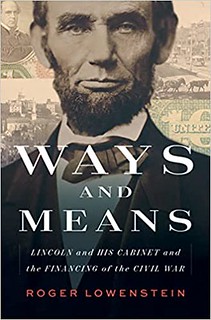 In one of the most momentous developments of the Civil War, the U.S. -- which had not had a national currency of any type to that point -- elected to begin printing currency. It was a highly contested decision, and yet that currency, which came to be called
In one of the most momentous developments of the Civil War, the U.S. -- which had not had a national currency of any type to that point -- elected to begin printing currency. It was a highly contested decision, and yet that currency, which came to be called greenbacks,
was a key early part of the successful financing of that war:
"In the desperate winter of 1861-1862, the financial crisis threatened to halt the Union armies. The Treasury was empty; the banks had suspended; the government had no currency. Chase had few ideas, other than a labored program for bank reform. Almost by default, the Republican Congress seized the initiative. The most likely vehicle for financial resuscitation was the House Ways and Means Committee. Ways and Means had two subcommittees. One dealt with revenue, but revenue legislation was unlikely to provide help in the near term. The other subcommittee, on currency, was chaired by Elbridge Spaulding of New York State. Spaulding had been working on Chase's proposal to reform the banks, but when the banks went off gold, Spaulding realized there would not be time. He himself was an investor and director in Bank of Attica and the Farmers and Mechanics' Bank, both in Buffalo. In the 1860s, it was not uncommon for representatives to tailor legislation affecting personal investments. Spaulding, who had been a popular Whig mayor before running for Congress, was untroubled by any idea of conflict of interest. He simply reckoned that the banking channel was stuck and it was in the public interest -- also in his private interest -- to unstick it. On December 30, 1861, with the Union nearly overwhelmed by fiscal problems, Spaulding reported another bill -- for a government currency.
"In theory, Spaulding could have proposed more of the Treasury demand notes, but as we have seen, the demand notes were refused in some quarters. Spaulding wanted a universally acceptable currency that the Treasury could use to pay for the war. His bill was revolutionary. As if by a conjurer's trick, it authorized the Treasury to print United States Notes to distribute to soldiers, suppliers, and others. The catch was that, unlike virtually every other bill in circulation, Spaulding's notes would not be redeemable for silver or gold. This meant the government would not be constrained by the supply of metal; it could print as much as it liked, or at any rate as much as Congress authorized.
"And Spaulding's notes would not pay interest. Today, we scarcely pause to consider that the money in our wallets does not yield a return. After all, it is 'money.' In 1861, virtually all government paper did pay interest. That was the inducement for holding it. Finally, Spaulding's paper would not have a maturity date. This, too, was unusual. A maturity date was a pledge that the paper could be exchanged for something of value at a specified time. But these notes would not be redeemable. They were issued for perpetuity.
"To the Civil War mind, these features were both shocking and blasphemous. Several years before the war, a Boston merchant named Samuel Hooper had published Currency or Money, a tract that had considered -- and denounced -- such a currency. Hooper did not mince words. 'They [paper bills] are not money,' he wrote disdainfully. 'They are, in fact, only promises to pay money.' The son of a shipper in Marblehead, Massachusetts, Hooper had learned finance at a countinghouse on State Street in Boston, and then become a prosperous businessman, trading in the Pacific Northwest and China. A savvy appraiser of financial risk, he had written that paper money was no more like the real thing than a contract to deliver flour was flour itself 'Paper money possesses no intrinsic value,' Hooper had patiently explained. 'It has only a derivative or secondary value, founded upon the good credit of those who issue it.'
"What, then, was Spaulding proposing to offer-if not an interest payment and not redemption at a maturity date -- to induce people to take his currency? Spaulding's U.S. Notes would be 'legal tender' they would be money by proclamation, that is, by government fiat. They would suffice for all debts and commercial exchanges; acceptance would be compulsory and universal.
"The legal tender debate was among the most profound of the war. Opponents maintained, and firmly believed, that issuing paper would cause a ruinous inflation. Thus far, inflation in the North had been relatively modest. But legislators were well aware that war currencies had come a cropper in the past, including in America during the Revolutionary War and in Britain and France during the Napoleonic era. Congressmen frequently quoted the Founding Fathers; all had been skeptical -- if not dead set against -- paper money.
To read the complete article, see:
THE DECISION TO ISSUE GREENBACKS -- 1/22/24
(https://www.delanceyplace.com/view-archives.php?p=4718)
To read the earlier E-Sylum article, see:
NEW BOOK: WAYS AND MEANS
(https://www.coinbooks.org/v25/esylum_v25n10a05.html)
ANTI-TRUMAN SCRIP OF 1952
A Society of Paper Money Collectors blog article by Loren Gatch about satirical banknotes relating to President Harry Truman. The article also goes on to discuss Eisenhower "Donkey Dollars." Here's an excerpt - see the complete article online. -Editor
Of the three pieces of scrip, the Truman Dollar
is the most enigmatic note. The front features a rather ungainly building that may be a rendering of the proposed Truman presidential library. Despite featuring the denomination 100
, the note is labeled Good for One Red Herring,
a reference to Truman's dismissive reaction, in 1948, to the House Un-American Activities Committee investigation into communist influence in the government, which he termed a red herring
meant to distract the American public from congressional inaction on the President's domestic priorities. Above that are the words, Made for Womans [sic] Brigade for Eisenhower.
Dating from March of 1952, just around the time that Truman announced his intention not to run, the Inflation Certificate
made something of a splash when it appeared, attracting newspaper commentary around the country and even some hostile scrutiny from the Secret Service, which objected to its anti-Truman parody of the U.S. dollar. Like their anti-LBJ product the Bettor Deal Certificate
that would appear twelve years later, Edwin James Mantooth and Graves Nellis (Jack
) Fulshear affected a yuk-yuk style of satirical humor that piled on reference after reference to Truman Administration peccadillos. In their overall effect, their notes were quite similar to the novelty currency put out at the time by another Houstonian, Leo Urban Luke
Kaiser, the owner of Premier Printing. An amateur magician and something of a jokester, Kaiser and his company produced a wide variety of gag money over the years, typically in exaggerated sizes, that made affectionate fun of their topics, notably the State of Texas. Unlike Mantooth and Fulshear, Kaiser steered clear of politics.
To read the complete article, see:
The Buck Stops Here: Anti-Truman Scrip of 1952
(https://spmc.org/blog/buck-stops-here-anti-truman-scrip-1952)
COMPUTER VISION REASSEMBLES SHREDDED BANK NOTES
Well, not exactly. But it's a great idea and can certainly help. -Editor
The fate of old notes is a critical issue for central banks that oversee their disposal. These notes cannot be thrown away like ordinary rubbish. Instead, central banks have developed standards to ensure the disposal is safe and secure.
This often involves a type of shredding that slices each note into hundreds of tiny pieces, each typically smaller than about thirty square millimeters. The shredded paper, or increasingly plastic, can then be disposed of, or recycled, off site.
Some central banks have even taken to selling shredded banknotes as souvenirs. And this raises the question of whether it is possible to reassemble the notes and reclaim them at face value.
Clearly manual re-assembly is a challenging task. But now Chung Kong, a PhD student at Hong Kong University, has shown that computer vision can help reassemble shredded notes at least partially.
Kong became intrigued after noticing that the Hong Kong Monetary Authority visitor center sells souvenir paperweights filled with shredded notes. Each paperweight, it says, contains the remains of 138 notes each worth HDK 1000 (equivalent to just over $100).
Kong imagined that, when reassembled, the notes ought to be worth HDK138,000. A tempting amount. And since computer vision systems can already solve jigsaw puzzles, he began the task of testing whether such a system might help reassemble a complete note.
Kong's approach was straightforward. He first scanned complete versions of the HDK1000 notes to create ground truth images
. He then broke open the paperweights, scanned each shredded piece, and cropped it to a rectangular form. Finally, he used a machine vision system to match the pattern on the shredded piece to a location on the ground truth image.
This process was hugely successful. It appears to be straightforward for a computer to find these locations.
However, there is another crucial step that Kong does not deal with in his paper. The shredded pieces are irregular shapes but the matching is done with parts of the patterns cropped into rectangles.
The problem is that the pieces may not have all come from the same note. So even if the computer vision system were to find matches for an entire note, there is no guarantee that those irregular pieces would fit together to form a complete note.
To read the complete article, see:
When One Man Used Computer Vision To Reassemble Shredded Bank Notes
(https://www.discovermagazine.com/technology/when-one-man-used-computer-vision-to-reassemble-shredded-bank-notes)
To read an earlier E-Sylum article, see:
TIME-LAPSE VIDEO: SHREDDED BANKNOTE RECONSTRUCTION
(https://www.coinbooks.org/v21/esylum_v21n04a36.html)


